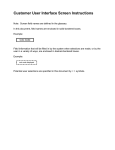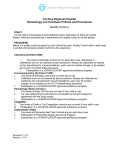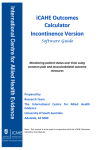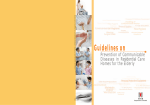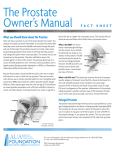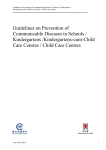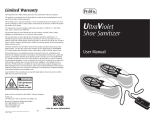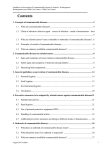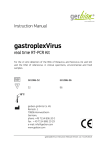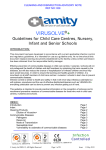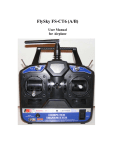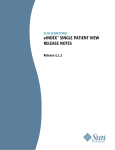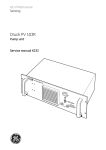Download Communicable diseases in RCHEs
Transcript
2 Communicable diseases in RCHEs Infective agents Mode of transmission Signs and symptoms Preventive measures Lower respiratory tract infections (e.g. acute bronchitis, pneumonia) Viruses (e.g. influenza viruses), bacteria (e.g. Streptococcus pneumoniae ) Droplets; touching of mucous membranes of the mouth, nose and eyes with hands contaminated with the infective agents Fever, fatigue, cough, thick sputum, sputum with blood, shortness of breath Observe respiratory hygiene/cough etiquette: any individual including residents should put on a surgical mask when there is respiratory symptom if applicable and tolerable. Urinary tract infections Bacteria (e.g. E. coli ) Usually caused by bacteria which move from the large intestine to the urinary tract. More commonly found in women, people with urinary catheters, diabetic, etc. Fever, urination with stabbing pain, frequent urination, urinary urgency, nocturia, urinary incontinence, lower abdominal pain, low back pain, hematuria, cloudy urine, etc. Maintain good personal hygiene; women should wipe their genitalia from the front to the back after urination; ensure adequate fluid intake; avoid holding back urine; avoid putting urinary bags at high position for people with urinary catheters; maintain good hygiene when changing urinary bags. 2.1 Common communicable diseases in RCHEs Information shows that the most common infections in elderly homes are respiratory tract infections, urinary tract infections, and skin or subcutaneous tissue infections. Other common infections include infectious gastrointestinal diseases and acute conjunctivitis. The typical signs and symptoms of these communicable diseases are listed as follows for staff reference. 08 Types of diseases Infective agents Mode of transmission Signs and symptoms Preventive measures Upper respiratory tract infections (e.g. influenza, common cold, rhinitis, laryngopharyngitis) Viruses (e.g. influenza viruses), bacteria (e.g. Streptococcus pneumoniae ) Droplets; touching of mucous membranes of the mouth, nose and eyes with hands contaminated with the infective agents Fever, fatigue, cough, sneeze, running nose, sore throat, muscle aches Maintain good ventilation and personal hygiene; perform hand hygiene before and after caring for each resident; may wear surgical masks during close contact with patients; have adequate rest and nutrition to build up body immunity. Guidelines on Prevention of Communicable Diseases in RCHEs Guidelines on Prevention of Communicable Diseases in RCHEs Co m m u n ica b le d ise a se s in RCHEs Co m m u n ica b le d ise a se s in RCHEs Types of diseases 09 2 Communicable diseases in RCHEs Infective agents Mode of transmission Signs and symptoms Preventive measures Lower respiratory tract infections (e.g. acute bronchitis, pneumonia) Viruses (e.g. influenza viruses), bacteria (e.g. Streptococcus pneumoniae ) Droplets; touching of mucous membranes of the mouth, nose and eyes with hands contaminated with the infective agents Fever, fatigue, cough, thick sputum, sputum with blood, shortness of breath Observe respiratory hygiene/cough etiquette: any individual including residents should put on a surgical mask when there is respiratory symptom if applicable and tolerable. Urinary tract infections Bacteria (e.g. E. coli ) Usually caused by bacteria which move from the large intestine to the urinary tract. More commonly found in women, people with urinary catheters, diabetic, etc. Fever, urination with stabbing pain, frequent urination, urinary urgency, nocturia, urinary incontinence, lower abdominal pain, low back pain, hematuria, cloudy urine, etc. Maintain good personal hygiene; women should wipe their genitalia from the front to the back after urination; ensure adequate fluid intake; avoid holding back urine; avoid putting urinary bags at high position for people with urinary catheters; maintain good hygiene when changing urinary bags. 2.1 Common communicable diseases in RCHEs Information shows that the most common infections in elderly homes are respiratory tract infections, urinary tract infections, and skin or subcutaneous tissue infections. Other common infections include infectious gastrointestinal diseases and acute conjunctivitis. The typical signs and symptoms of these communicable diseases are listed as follows for staff reference. 08 Types of diseases Infective agents Mode of transmission Signs and symptoms Preventive measures Upper respiratory tract infections (e.g. influenza, common cold, rhinitis, laryngopharyngitis) Viruses (e.g. influenza viruses), bacteria (e.g. Streptococcus pneumoniae ) Droplets; touching of mucous membranes of the mouth, nose and eyes with hands contaminated with the infective agents Fever, fatigue, cough, sneeze, running nose, sore throat, muscle aches Maintain good ventilation and personal hygiene; perform hand hygiene before and after caring for each resident; may wear surgical masks during close contact with patients; have adequate rest and nutrition to build up body immunity. Guidelines on Prevention of Communicable Diseases in RCHEs Guidelines on Prevention of Communicable Diseases in RCHEs Co m m u n ica b le d ise a se s in RCHEs Co m m u n ica b le d ise a se s in RCHEs Types of diseases 09 Signs and symptoms Preventive measures Skin and Parasites (e.g. Contact subcutaneous scabies, head transmission tissue infections lice), bacteria (e.g. Staphylococcus aureus, aureus Streptococcus pneumoniae pneumoniae), fungi (e.g. moniliasis, tinea) Itching, localized rash, desquamation, swelling, scales, etc, suppurating or smelly wounds (e.g. pressure sores) Wear gloves during patient contact and arrange early medical treatment for the patients; disinfect the linen and clothing of patients with scabies following protocol or instruction. Infectious Viruses (e.g. gastrointestinal rotaviruses, diseases Noroviruses), bacteria (e.g. Salmonella, Staphylococcus aureus Vibrio aureus, cholerae cholerae) Consuming contaminated food or water; contact with vomitus or faeces from infected persons, contaminated object, or aerosols (in case of Norovirus infection (Appendix N)) Abdominal pain, vomiting, diarrhoea, lack of appetite, fatigue, fever Maintain good personal, food and environmental hygiene; wash hands after using the toilet; food handlers should refrain from work and seek early medical advice if falling sick; proper handling of vomitus and excreta. Contact transmission Redness of eyes, itching eyes, excessive tears, abnormal secretion Acute conjunctivitis 10 Infective agents Viruses, bacteria Mode of transmission Guidelines on Prevention of Communicable Diseases in RCHEs Never share towels; observe good personal hygiene; perform hand hygiene before touching the eyes. 2.2 Other important communicable diseases in RCHEs Types of diseases Infective agents Mode of transmission AIDS Viruses Blood/body fluid Cannot resist the invasion of transmission infective agents because of impaired body immunity. No specific symptoms. May have persistent fever, uncommon infections and/or tumors etc. Hepatitis B Viruses Blood/body fluid Fever, jaundice, Ditto. fatigue, loss of Staff may also transmission appetite consider vaccination against hepatitis B. Pulmonary Mycobacterium Airborne tuberculosis transmission tuberculosis tuberculosis (smear positive) Signs and symptoms Persistent fever, cough, sputum with blood, fatigue, weight loss, night sweating Preventive measures Never share toothbrushes, razors or other objects likely contaminated by blood. Standard precautions should be strictly followed when clearing up objects contaminated by blood. Avoid unprotected/ unsafe sex. Co m m u n ica b le d ise a se s in RCHEs Co m m u n ica b le d ise a se s in RCHEs Types of diseases Have adequate rest and nutrition; maintain good ventilation and environmental hygiene. Do not spit. Observe respiratory hygiene/cough etiquette: any individual including residents should put on a surgical mask when there is respiratory symptom if applicable and tolerable. Guidelines on Prevention of Communicable Diseases in RCHEs 11 Signs and symptoms Preventive measures Skin and Parasites (e.g. Contact subcutaneous scabies, head transmission tissue infections lice), bacteria (e.g. Staphylococcus aureus, aureus Streptococcus pneumoniae pneumoniae), fungi (e.g. moniliasis, tinea) Itching, localized rash, desquamation, swelling, scales, etc, suppurating or smelly wounds (e.g. pressure sores) Wear gloves during patient contact and arrange early medical treatment for the patients; disinfect the linen and clothing of patients with scabies following protocol or instruction. Infectious Viruses (e.g. gastrointestinal rotaviruses, diseases Noroviruses), bacteria (e.g. Salmonella, Staphylococcus aureus Vibrio aureus, cholerae cholerae) Consuming contaminated food or water; contact with vomitus or faeces from infected persons, contaminated object, or aerosols (in case of Norovirus infection (Appendix N)) Abdominal pain, vomiting, diarrhoea, lack of appetite, fatigue, fever Maintain good personal, food and environmental hygiene; wash hands after using the toilet; food handlers should refrain from work and seek early medical advice if falling sick; proper handling of vomitus and excreta. Contact transmission Redness of eyes, itching eyes, excessive tears, abnormal secretion Acute conjunctivitis 10 Infective agents Viruses, bacteria Mode of transmission Guidelines on Prevention of Communicable Diseases in RCHEs Never share towels; observe good personal hygiene; perform hand hygiene before touching the eyes. 2.2 Other important communicable diseases in RCHEs Types of diseases Infective agents Mode of transmission AIDS Viruses Blood/body fluid Cannot resist the invasion of transmission infective agents because of impaired body immunity. No specific symptoms. May have persistent fever, uncommon infections and/or tumors etc. Hepatitis B Viruses Blood/body fluid Fever, jaundice, Ditto. fatigue, loss of Staff may also transmission appetite consider vaccination against hepatitis B. Pulmonary Mycobacterium Airborne tuberculosis transmission tuberculosis tuberculosis (smear positive) Signs and symptoms Persistent fever, cough, sputum with blood, fatigue, weight loss, night sweating Preventive measures Never share toothbrushes, razors or other objects likely contaminated by blood. Standard precautions should be strictly followed when clearing up objects contaminated by blood. Avoid unprotected/ unsafe sex. Co m m u n ica b le d ise a se s in RCHEs Co m m u n ica b le d ise a se s in RCHEs Types of diseases Have adequate rest and nutrition; maintain good ventilation and environmental hygiene. Do not spit. Observe respiratory hygiene/cough etiquette: any individual including residents should put on a surgical mask when there is respiratory symptom if applicable and tolerable. Guidelines on Prevention of Communicable Diseases in RCHEs 11 Infective agents Mode of transmission Signs and symptoms Preventive measures Myiasis Larvae of flies Flies lay their eggs on mucous membranes or wounds Larvae crawl out from the mouth, wound etc. and there are purulent and smelly discharges Maintain good oral hygiene for residents especially for those requiring nasogastric tubes for feeding. Wounds should be properly treated. Maintain good environmental hygiene. Install appropriate fly screen and repellent devices. *SARS Coronaviruses Droplets, touching of mucous membranes of the mouth, nose and eyes with hands contaminated with the infective agents Fever, fatigue, headache, chill, cough, shortness of breath, difficulty in breathing, diarrhoea Have adequate rest and nutrition to build up body immunity. Observe good personal hygiene. Wear surgical masks. Perform hand hygiene before and after resident contact. Maintain good ventilation and environmental hygiene. Note: *For detailed guidelines on the prevention of SARS, please visit the following websites: www.info.gov.hk/info/sars/eindex.htm; www.elderly.gov.hk; www.swd.gov.hk 12 Guidelines on Prevention of Communicable Diseases in RCHEs 2.3 Early signs and symptoms of infection in the elderly 2.3.1 Although most elders develop the above common symptoms when infected, some elders (especially those older and feeble ones) may have less obvious symptoms. When they are infected, it would be more difficult to detect and treatment would be delayed, thus increase the risk of transmission. For those with cognitive impairment (such as elders with dementia), communication problems with carers may arise, leading to late detection of infection. Co m m u n ica b le d ise a se s in RCHEs Co m m u n ica b le d ise a se s in RCHEs Types of diseases 2.3.2 Carers should carefully look for the following signs and symptoms which may indicate infection in the elders. • The body temperature is 1 oC higher than the usual temperature: Most elders have fever when severely infected, but the body temperature for some may not exceed the normal range. If the temperature is 1 oC higher than his/her usual body temperature, he/she may have underlying infection. • Disoriented, confusion, restlessness: Many diseases may cause such symptoms in the elders. Infection is one of the important causes for such symptoms. If the elders, especially the frail ones with chronic illnesses, are found to develop such symptoms, carers should arrange them to seek medical advice promptly. • Unexplained changes in behaviours and body functions: Unexplained behavioural changes may be caused by mental confusion. Changes of body functions like loss of bladder control may be due to infection like urethritis, or secondary to confusion. • Loss of appetite and/or unexplained weight loss • Weaker than usual • Lethargy • Fall • Shortness of breath • Palpitation Guidelines on Prevention of Communicable Diseases in RCHEs 13 Infective agents Mode of transmission Signs and symptoms Preventive measures Myiasis Larvae of flies Flies lay their eggs on mucous membranes or wounds Larvae crawl out from the mouth, wound etc. and there are purulent and smelly discharges Maintain good oral hygiene for residents especially for those requiring nasogastric tubes for feeding. Wounds should be properly treated. Maintain good environmental hygiene. Install appropriate fly screen and repellent devices. *SARS Coronaviruses Droplets, touching of mucous membranes of the mouth, nose and eyes with hands contaminated with the infective agents Fever, fatigue, headache, chill, cough, shortness of breath, difficulty in breathing, diarrhoea Have adequate rest and nutrition to build up body immunity. Observe good personal hygiene. Wear surgical masks. Perform hand hygiene before and after resident contact. Maintain good ventilation and environmental hygiene. Note: *For detailed guidelines on the prevention of SARS, please visit the following websites: www.info.gov.hk/info/sars/eindex.htm; www.elderly.gov.hk; www.swd.gov.hk 12 Guidelines on Prevention of Communicable Diseases in RCHEs 2.3 Early signs and symptoms of infection in the elderly 2.3.1 Although most elders develop the above common symptoms when infected, some elders (especially those older and feeble ones) may have less obvious symptoms. When they are infected, it would be more difficult to detect and treatment would be delayed, thus increase the risk of transmission. For those with cognitive impairment (such as elders with dementia), communication problems with carers may arise, leading to late detection of infection. Co m m u n ica b le d ise a se s in RCHEs Co m m u n ica b le d ise a se s in RCHEs Types of diseases 2.3.2 Carers should carefully look for the following signs and symptoms which may indicate infection in the elders. • The body temperature is 1 oC higher than the usual temperature: Most elders have fever when severely infected, but the body temperature for some may not exceed the normal range. If the temperature is 1 oC higher than his/her usual body temperature, he/she may have underlying infection. • Disoriented, confusion, restlessness: Many diseases may cause such symptoms in the elders. Infection is one of the important causes for such symptoms. If the elders, especially the frail ones with chronic illnesses, are found to develop such symptoms, carers should arrange them to seek medical advice promptly. • Unexplained changes in behaviours and body functions: Unexplained behavioural changes may be caused by mental confusion. Changes of body functions like loss of bladder control may be due to infection like urethritis, or secondary to confusion. • Loss of appetite and/or unexplained weight loss • Weaker than usual • Lethargy • Fall • Shortness of breath • Palpitation Guidelines on Prevention of Communicable Diseases in RCHEs 13 2.3.3 2.4 Management of suspected cases of communicable diseases among residents or staff The operator of RCHE should appoint either a nurse or a health worker as an Infection Control Officer (ICO) who is the key person responsible for dealing with matters related to infection control and prevention of the spread of infectious diseases in the residential care home. ICOs should observe the following principles in preventing the spread of communicable diseases: • Medical surveillance - maintain and keep proper personal health records of residents, and carefully assess their signs and symptoms. • Early treatment - to avoid secondary spread by the infected residents or staff. • Spread prevention - appropriate isolation precautions should be adopted with respect to the mode of transmission of respective communicable diseases to avoid outbreaks and further evolution into an epidemic. For example, patients with respiratory tract infections should wear masks; excreta of elders should be properly disposed of; the guidelines for hand hygiene should be strictly observed etc. If in doubt, promptly notify CENO and the Licensing Office of Residential Care Homes for the Elderly of the Social Welfare Department for follow-up investigation. NB. The duty list of ICOs is detailed in Appendix B. 14 Guidelines on Prevention of Communicable Diseases in RCHEs 2.5 Measuring body temperature 2.5.1 The importance of taking body temperature Most elders develop fever when infected, but there are exceptions. Some elders have lower baseline body temperatures, which rise slightly when they are infected but still within the normal range. Effective surveillance of body temperature changes can only be carried out when self-comparison can be made with the usual body temperature of the elders. RCHE staff should thus regularly take accurate body temperature for the elders. Temperature should be taken more frequently under the following circumstances: • Residents with communication problems and those who are feeble • During outbreaks of communicable diseases, particularly influenza-like illnesses and SARS • When residents develop symptoms of infection (please refer to Appendix C for details) • Residents newly discharged from hospital Co m m u n ica b le d ise a se s in RCHEs Co m m u n ica b le d ise a se s in RCHEs The above are the common bodily changes among the infected elders. To detect such changes, carers should familiarize themselves with the daily physical conditions and behavioural patterns of the elders. As such, proper personal health records should be maintained for each resident and their temperatures checked regularly. In addition, carers should pay more attention to elders who have special health conditions or with medical devices attached to their bodies, since they are more vulnerable to infection than others. For details, please refer to the checklist of signs and symptoms of communicable diseases in Appendix C. The checklist is a reminder to help infection control officers (ICOs) to carry out preliminary health assessment on individual residents for early detection of infections and prompt medical treatment. 2.5.2 What should be done when residents develop fever? The normal temperature of human body (oral temperature) ranges from 36.1 oC to 37.2 oC. If a resident is found to have fever or have a temperature being 1 oC higher than his usual one, staff should be alert and note it down on the fever record for residents (see Appendix D) and the resident's personal health record. The ICO should read the fever record everyday for early detection of residents with health problems, and check against the checklist of signs and symptoms of communicable diseases in Appendix C. Assistance can be sought from the Visiting Medical Officer (VMO) or the healthcare workers of the Community Geriatric Assessment Team (CGAT) when necessary. 2.5.3 Accurate measurement of body temperature Body temperature can be divided into core temperature and surface temperature. Core temperature refers to the temperature of deep tissues, which can be taken through the oral cavity, rectum or ear, whereas surface temperature is the temperature of surface skin tissues, which can be taken through the armpit. Surface temperature is more susceptible to changes in the surroundings. To avoid inaccuracy in measurement, the following should be noted: Guidelines on Prevention of Communicable Diseases in RCHEs 15 2.3.3 2.4 Management of suspected cases of communicable diseases among residents or staff The operator of RCHE should appoint either a nurse or a health worker as an Infection Control Officer (ICO) who is the key person responsible for dealing with matters related to infection control and prevention of the spread of infectious diseases in the residential care home. ICOs should observe the following principles in preventing the spread of communicable diseases: • Medical surveillance - maintain and keep proper personal health records of residents, and carefully assess their signs and symptoms. • Early treatment - to avoid secondary spread by the infected residents or staff. • Spread prevention - appropriate isolation precautions should be adopted with respect to the mode of transmission of respective communicable diseases to avoid outbreaks and further evolution into an epidemic. For example, patients with respiratory tract infections should wear masks; excreta of elders should be properly disposed of; the guidelines for hand hygiene should be strictly observed etc. If in doubt, promptly notify CENO and the Licensing Office of Residential Care Homes for the Elderly of the Social Welfare Department for follow-up investigation. NB. The duty list of ICOs is detailed in Appendix B. 14 Guidelines on Prevention of Communicable Diseases in RCHEs 2.5 Measuring body temperature 2.5.1 The importance of taking body temperature Most elders develop fever when infected, but there are exceptions. Some elders have lower baseline body temperatures, which rise slightly when they are infected but still within the normal range. Effective surveillance of body temperature changes can only be carried out when self-comparison can be made with the usual body temperature of the elders. RCHE staff should thus regularly take accurate body temperature for the elders. Temperature should be taken more frequently under the following circumstances: • Residents with communication problems and those who are feeble • During outbreaks of communicable diseases, particularly influenza-like illnesses and SARS • When residents develop symptoms of infection (please refer to Appendix C for details) • Residents newly discharged from hospital Co m m u n ica b le d ise a se s in RCHEs Co m m u n ica b le d ise a se s in RCHEs The above are the common bodily changes among the infected elders. To detect such changes, carers should familiarize themselves with the daily physical conditions and behavioural patterns of the elders. As such, proper personal health records should be maintained for each resident and their temperatures checked regularly. In addition, carers should pay more attention to elders who have special health conditions or with medical devices attached to their bodies, since they are more vulnerable to infection than others. For details, please refer to the checklist of signs and symptoms of communicable diseases in Appendix C. The checklist is a reminder to help infection control officers (ICOs) to carry out preliminary health assessment on individual residents for early detection of infections and prompt medical treatment. 2.5.2 What should be done when residents develop fever? The normal temperature of human body (oral temperature) ranges from 36.1 oC to 37.2 oC. If a resident is found to have fever or have a temperature being 1 oC higher than his usual one, staff should be alert and note it down on the fever record for residents (see Appendix D) and the resident's personal health record. The ICO should read the fever record everyday for early detection of residents with health problems, and check against the checklist of signs and symptoms of communicable diseases in Appendix C. Assistance can be sought from the Visiting Medical Officer (VMO) or the healthcare workers of the Community Geriatric Assessment Team (CGAT) when necessary. 2.5.3 Accurate measurement of body temperature Body temperature can be divided into core temperature and surface temperature. Core temperature refers to the temperature of deep tissues, which can be taken through the oral cavity, rectum or ear, whereas surface temperature is the temperature of surface skin tissues, which can be taken through the armpit. Surface temperature is more susceptible to changes in the surroundings. To avoid inaccuracy in measurement, the following should be noted: Guidelines on Prevention of Communicable Diseases in RCHEs 15 2.5.4 Choice of thermometers In general, there are mercury, digital, chemical LCD and infrared ear thermometers, etc for taking oral, rectal, armpit, ear and forehead temperature. Before using a specific thermometer, read the instructions carefully for the proper procedures of using the thermometer and the reference range of the readings. Accuracy, suitability and convenience should all be taken into account when choosing the appropriate thermometer. RCHEs that require rapid temperature taking because of the setting and working conditions may use infrared forehead thermometers. Such devices, however, are less accurate in reflecting the true core body temperature. Hence, unless absolutely necessary, it should be avoided as far as possible as the only type of thermometer used for taking temperature. 2.5.5 Methods of taking body temperature Taking ear temperature: It is non-invasive and therefore has little limitations on its application. It is particularly suitable and recommended for use in RCHEs. First, stabilize the head position of the resident. Pull the ear backwards and upwards to make the ear canal straight. Fit the probe tip covered with a plastic jacket slightly into the depth of the ear canal. The temperature taken from the ear is 0.5 oC higher than the oral temperature. Follow the instructions to make suitable adjustments when using an ear thermometer. Points to note: - Direction of the probe tip should be correct, otherwise it will give an inaccurate reading. - The ear pressed against the pillow during sleeping has a higher temperature, so the other ear should be used for taking temperature if one is just awake. - Not applicable to elders with obstruction of ear canal caused by ear wax or otitis. 16 Guidelines on Prevention of Communicable Diseases in RCHEs • Taking oral temperature: Suitable for elders who are conscious, cooperative and who can close their mouths tight. Staff should place the thermometer under the tongue near the root. Instruct the resident to close the mouth tight but not to bite on the thermometer or talk. Wait for 3 to 5 minutes when using a mercury thermometer before checking the reading. If the resident carelessly bites off the mercury thermometer, he/she should be sent to the hospital immediately for treatment. Points to note: - Close the mouth when taking temperature. Do not speak. - Avoid cold or hot food before taking temperature. - Not applicable to residents who are unconscious, confused or who cannot close their mouths tight. Co m m u n ica b le d ise a se s in RCHEs Co m m u n ica b le d ise a se s in RCHEs • Residents should avoid exercise or having excessively cold or hot food and drinks within 30 minutes before taking temperature. • To familiarize with the correct use of thermometers before taking temperature. • For each particular resident, it is preferable to take the daily temperature from the same body part at the same time of the day using the same temperature taking method to avoid deviations caused by changes in the surroundings or the use of different measurement methods. • Taking armpit temperature: Suitable for conditions when all the above are not applicable. Ensure privacy and protect the residents from catching cold when taking temperature. Put the thermometer under the armpit, and place the forearm of the resident horizontally on the chest to keep the thermometer in position. Wait for 6 to 8 minutes before checking the reading. Armpit temperature is usually 0.5 oC lower than oral temperature, so it should be recorded as the armpit temperature. Points to note: - The thermometer should be held tight under the armpit without clothes in between when taking temperature. 2.5.6 Cleaning and disinfection of body temperature measuring instrument after use • Mercury thermometer - wash with cold water and detergent first; immerse in 70% alcohol for not less than 10 minutes; air dry and then store in dry place. • Oral and rectal thermometers should be treated separately. Patients with communicable diseases should use separate personal thermometers to avoid cross-infection. • Electronic thermometers must not be immersed in disinfectants or disinfected with high heat because it will damage the electronic components and affect the instrument's normal functioning. The cleaning procedures recommended in the user manual of the electronic thermometers should be followed. Guidelines on Prevention of Communicable Diseases in RCHEs 17 2.5.4 Choice of thermometers In general, there are mercury, digital, chemical LCD and infrared ear thermometers, etc for taking oral, rectal, armpit, ear and forehead temperature. Before using a specific thermometer, read the instructions carefully for the proper procedures of using the thermometer and the reference range of the readings. Accuracy, suitability and convenience should all be taken into account when choosing the appropriate thermometer. RCHEs that require rapid temperature taking because of the setting and working conditions may use infrared forehead thermometers. Such devices, however, are less accurate in reflecting the true core body temperature. Hence, unless absolutely necessary, it should be avoided as far as possible as the only type of thermometer used for taking temperature. 2.5.5 Methods of taking body temperature Taking ear temperature: It is non-invasive and therefore has little limitations on its application. It is particularly suitable and recommended for use in RCHEs. First, stabilize the head position of the resident. Pull the ear backwards and upwards to make the ear canal straight. Fit the probe tip covered with a plastic jacket slightly into the depth of the ear canal. The temperature taken from the ear is 0.5 oC higher than the oral temperature. Follow the instructions to make suitable adjustments when using an ear thermometer. Points to note: - Direction of the probe tip should be correct, otherwise it will give an inaccurate reading. - The ear pressed against the pillow during sleeping has a higher temperature, so the other ear should be used for taking temperature if one is just awake. - Not applicable to elders with obstruction of ear canal caused by ear wax or otitis. 16 Guidelines on Prevention of Communicable Diseases in RCHEs • Taking oral temperature: Suitable for elders who are conscious, cooperative and who can close their mouths tight. Staff should place the thermometer under the tongue near the root. Instruct the resident to close the mouth tight but not to bite on the thermometer or talk. Wait for 3 to 5 minutes when using a mercury thermometer before checking the reading. If the resident carelessly bites off the mercury thermometer, he/she should be sent to the hospital immediately for treatment. Points to note: - Close the mouth when taking temperature. Do not speak. - Avoid cold or hot food before taking temperature. - Not applicable to residents who are unconscious, confused or who cannot close their mouths tight. Co m m u n ica b le d ise a se s in RCHEs Co m m u n ica b le d ise a se s in RCHEs • Residents should avoid exercise or having excessively cold or hot food and drinks within 30 minutes before taking temperature. • To familiarize with the correct use of thermometers before taking temperature. • For each particular resident, it is preferable to take the daily temperature from the same body part at the same time of the day using the same temperature taking method to avoid deviations caused by changes in the surroundings or the use of different measurement methods. • Taking armpit temperature: Suitable for conditions when all the above are not applicable. Ensure privacy and protect the residents from catching cold when taking temperature. Put the thermometer under the armpit, and place the forearm of the resident horizontally on the chest to keep the thermometer in position. Wait for 6 to 8 minutes before checking the reading. Armpit temperature is usually 0.5 oC lower than oral temperature, so it should be recorded as the armpit temperature. Points to note: - The thermometer should be held tight under the armpit without clothes in between when taking temperature. 2.5.6 Cleaning and disinfection of body temperature measuring instrument after use • Mercury thermometer - wash with cold water and detergent first; immerse in 70% alcohol for not less than 10 minutes; air dry and then store in dry place. • Oral and rectal thermometers should be treated separately. Patients with communicable diseases should use separate personal thermometers to avoid cross-infection. • Electronic thermometers must not be immersed in disinfectants or disinfected with high heat because it will damage the electronic components and affect the instrument's normal functioning. The cleaning procedures recommended in the user manual of the electronic thermometers should be followed. Guidelines on Prevention of Communicable Diseases in RCHEs 17










